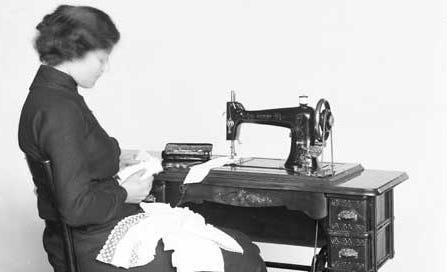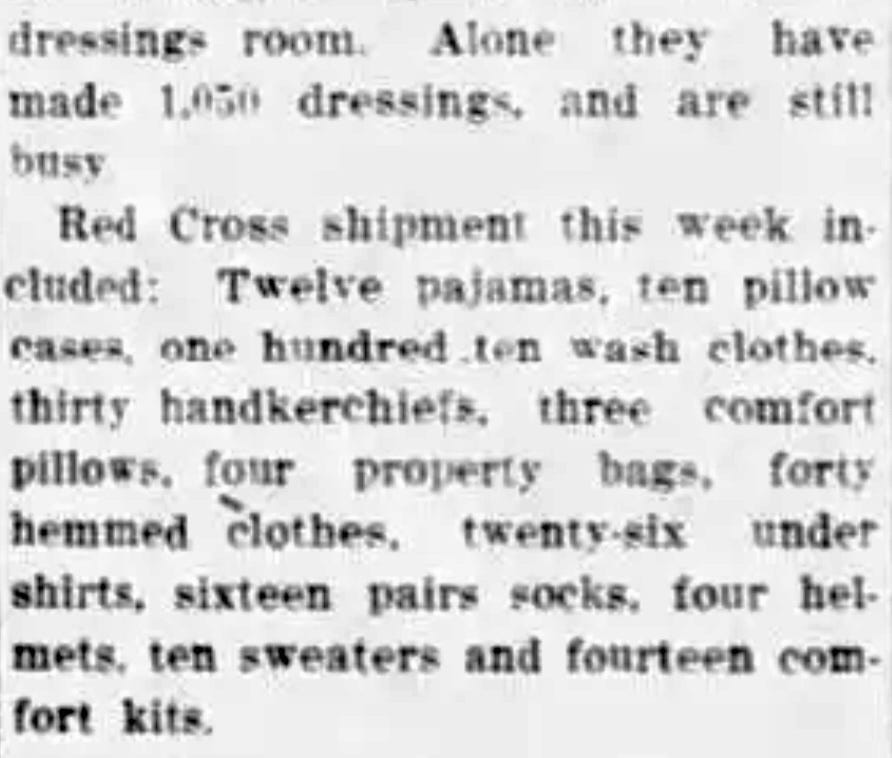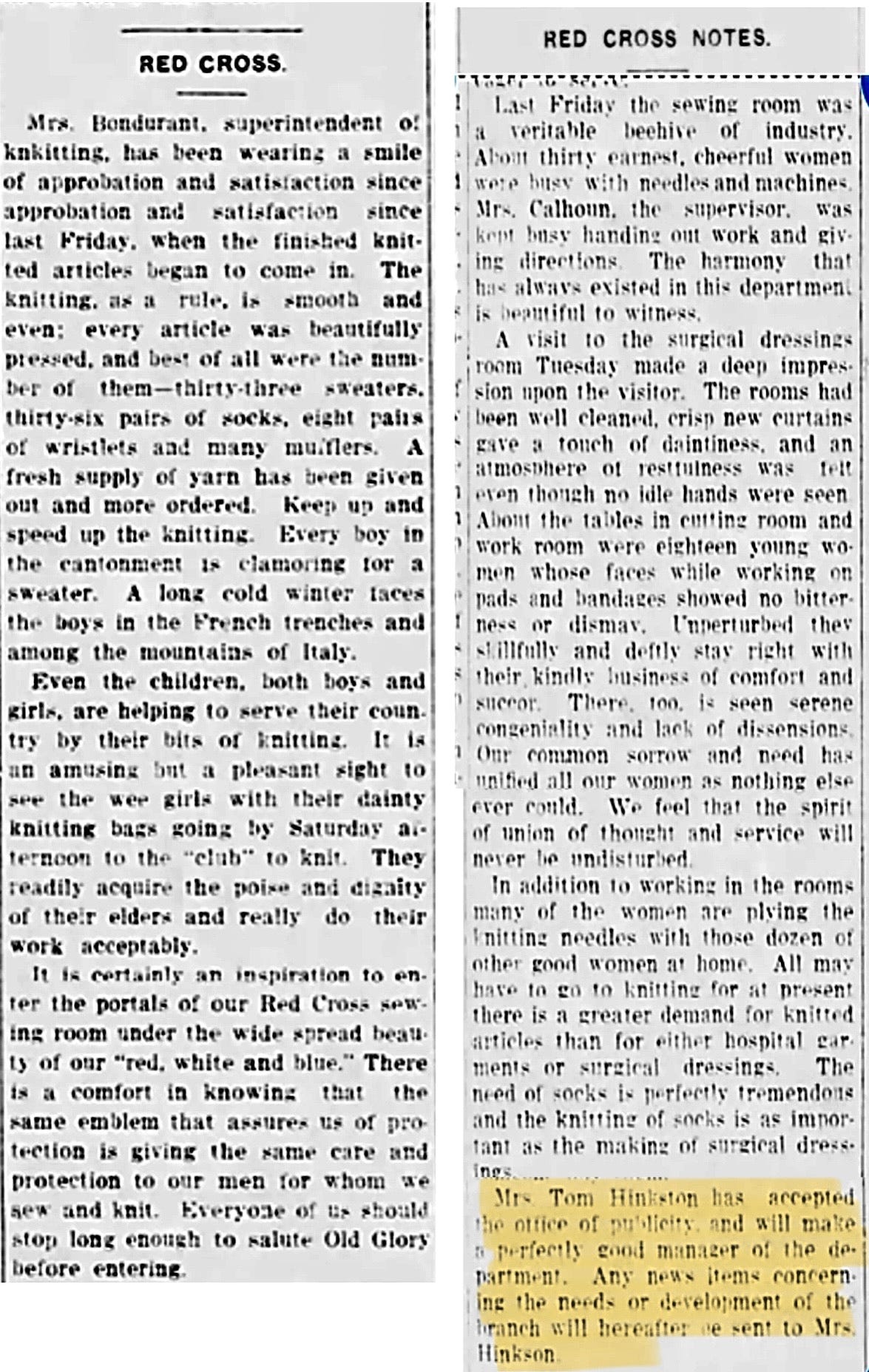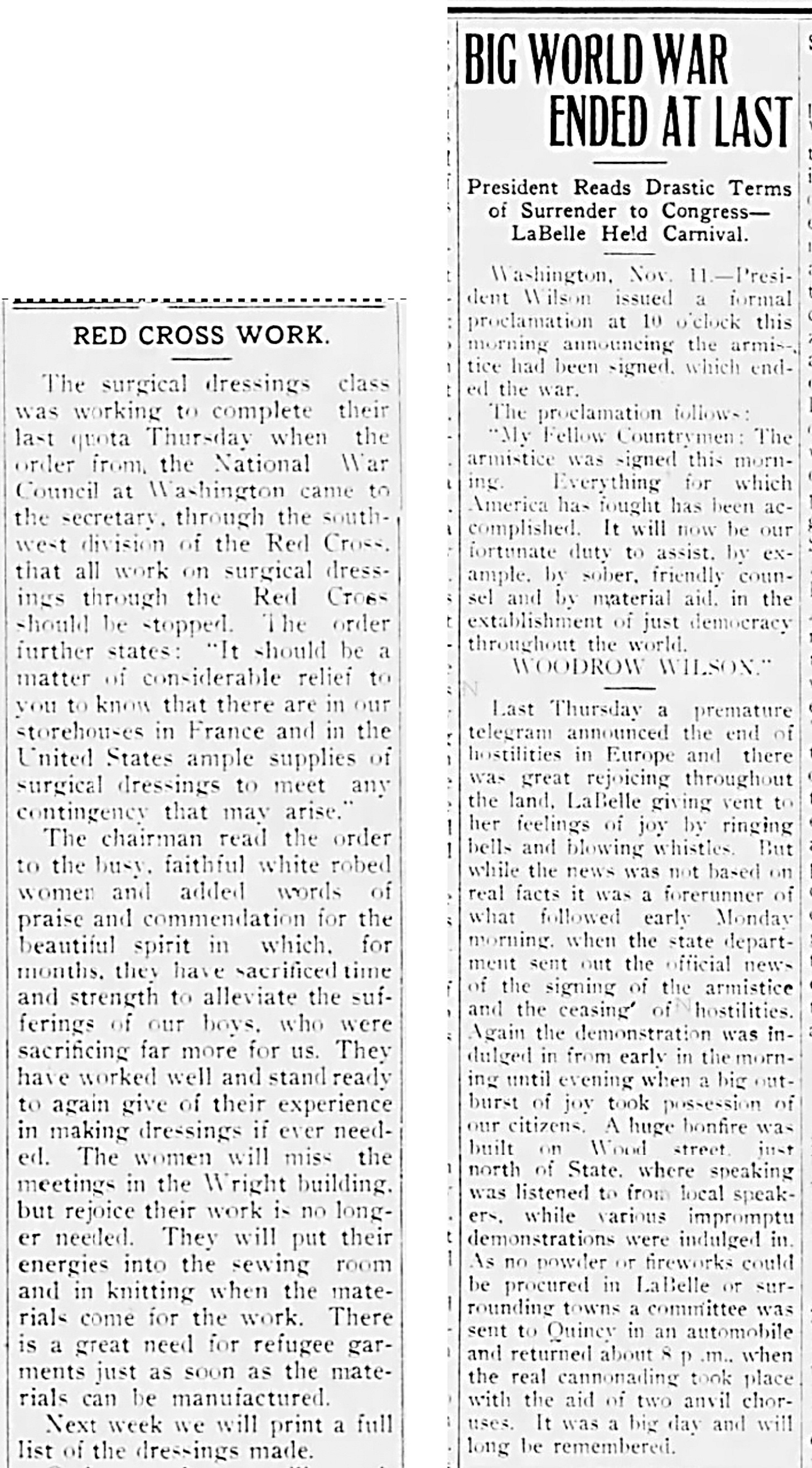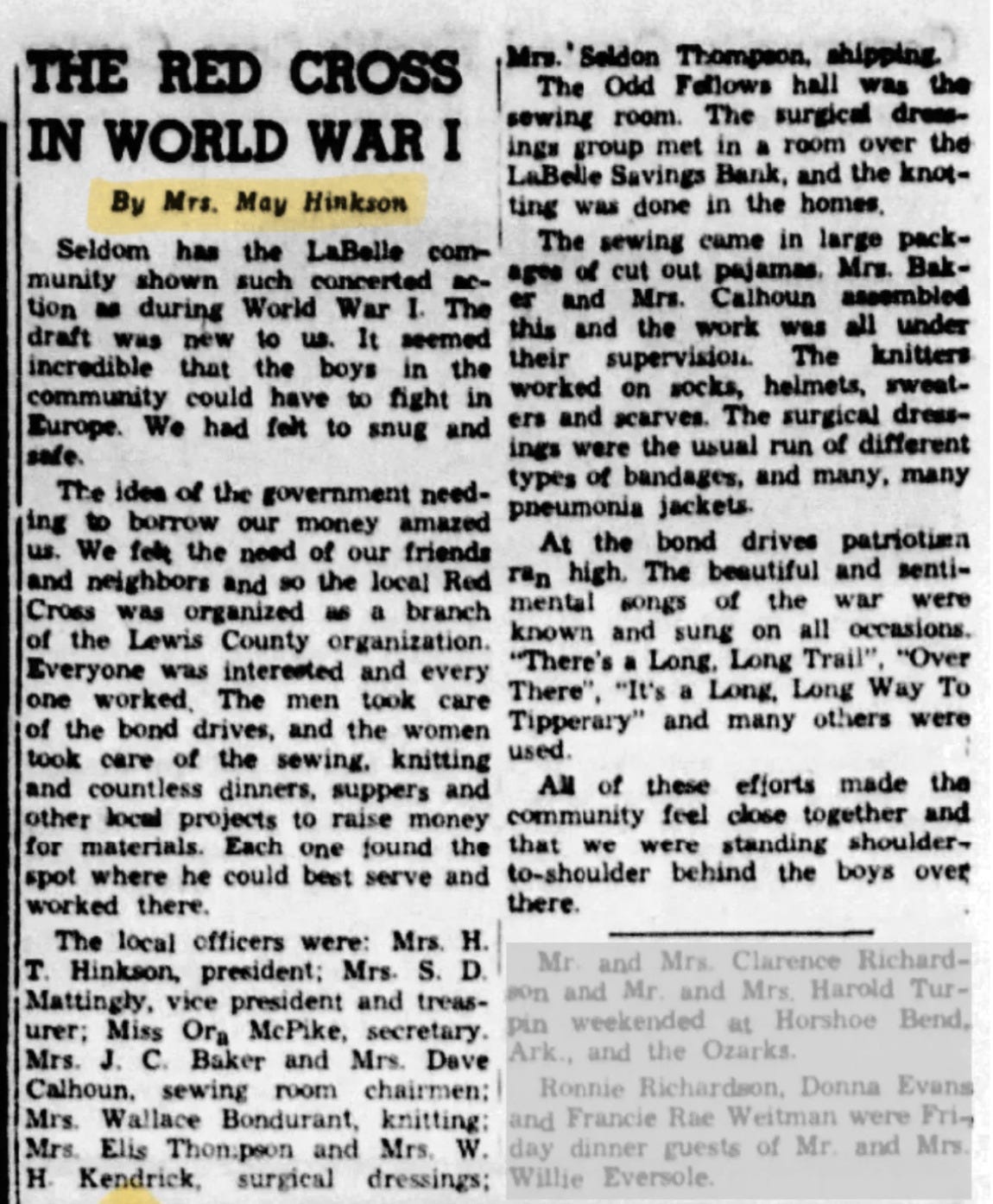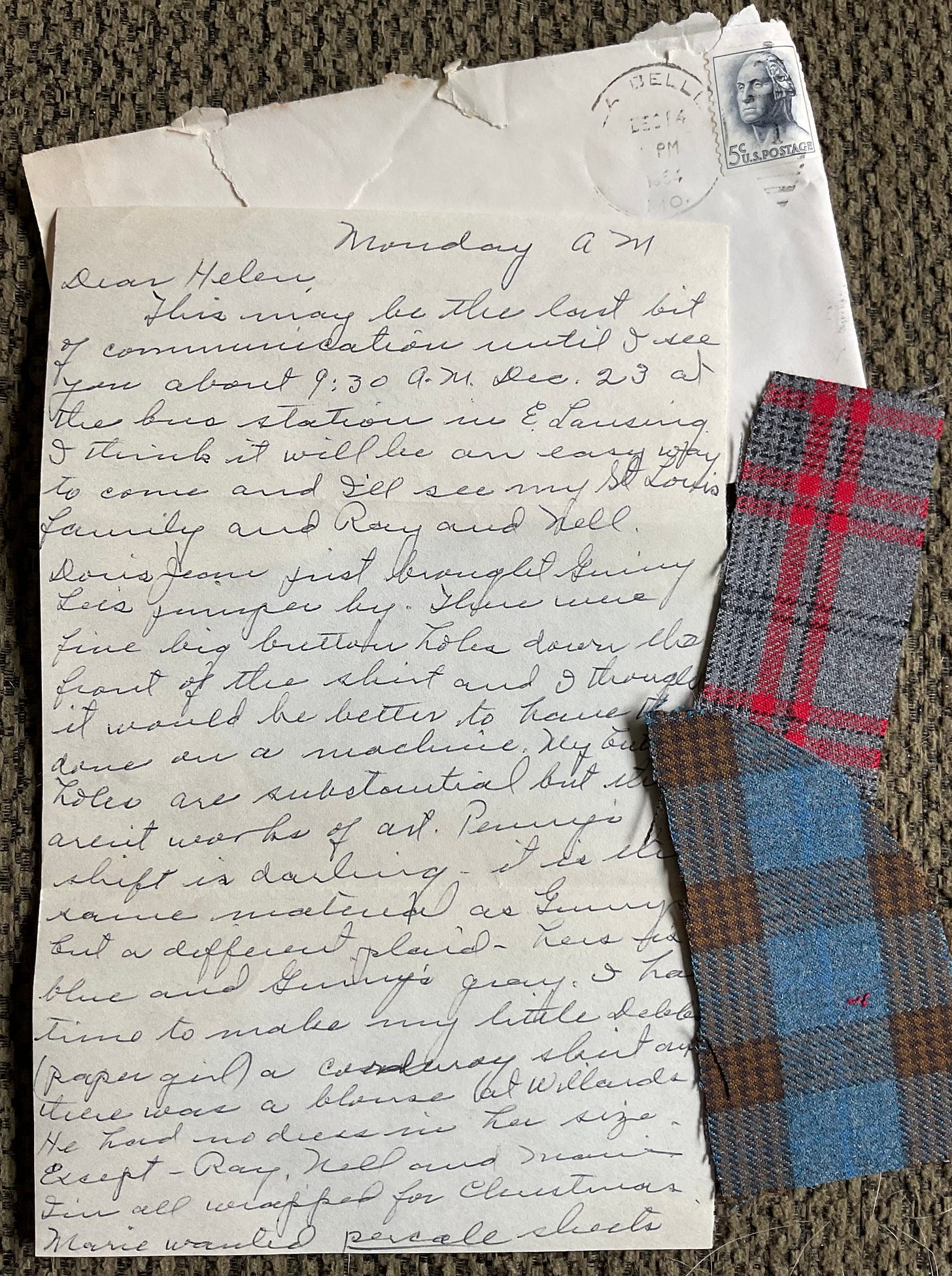A trusty treadle machine & sewing for “Sammies”
… a look back at May Hinkson’s (1880-1975) “language of love” & Red Cross support during the “Great War”
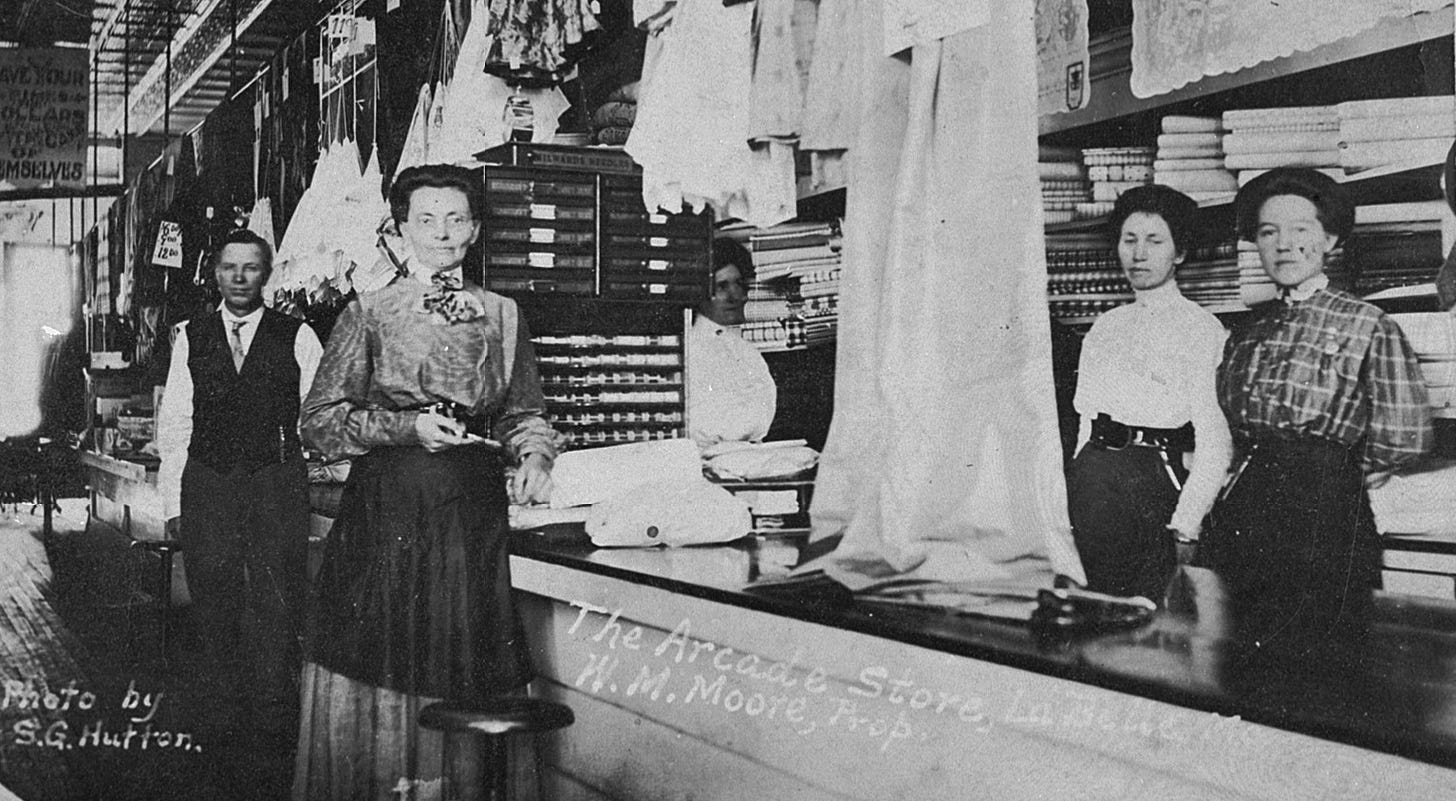
Have you ever stumbled upon an old photo that quietly whispers “There’s a story here?” That’s how I felt when I first saw this photo (above) of store clerks and dozens of bolts of material lining the wall inside the Arcade Store located in my great-grandmother’s hometown of LaBelle, MO.
In looking at the photo, I felt sure it was a view that my great-grandmother had personally encountered many times in her lifetime. Walking into the Arcade, I imagine her being greeted with a pleasant “Hello, Mrs. Hinkson. What can we help you with today?”. As she walked over to the “dress goods” counter, the pleasantries and conversation continued as she spent time selecting just the right material, buttons, and/ or lace for her latest sewing project. If May Emma Northcutt Hinkson (1880-1975) were alive today, I feel confident that she could not only name all five faces in the photo but could tell me two or three of the individuals’ life stories. That’s how small LaBelle, MO was. Everyone pretty much knew everybody, whether it was through business, church, or social activities.
The Arcade Store was the premiere LaBelle establishment for clothing, shoes, housewares, notions and laces, and all types of “stable dry goods.”
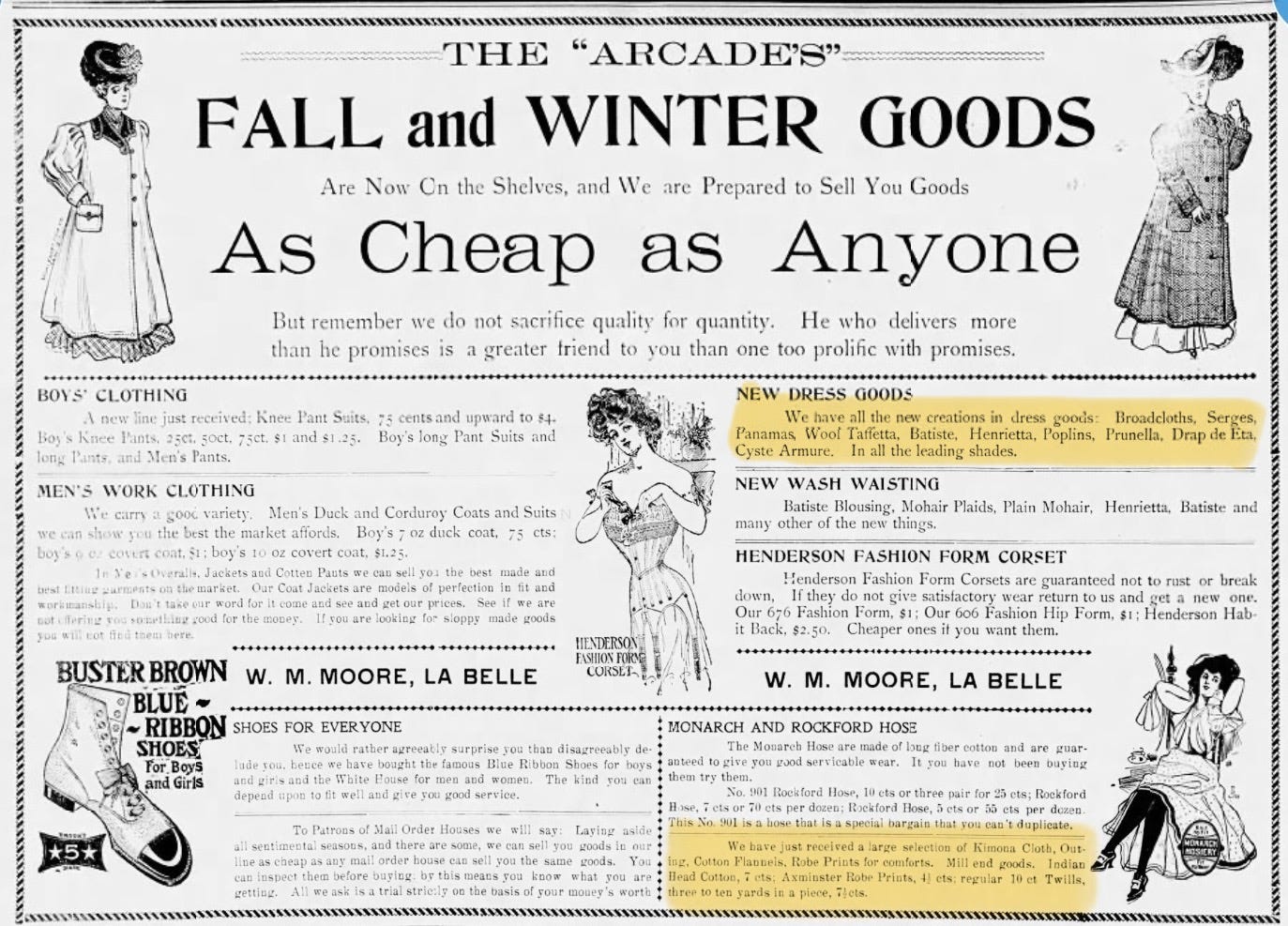
The story that this photo calls on me to write is a story that I have easily overlooked through the first one hundred of my great-grandmother’s weekly letters. It’s a story about resourcefulness… a story about community connections… but mostly, above all, it’s a story about the love that revolved around one of my great-grandmother’s favorite activities… sewing.
My great-grandmother May was a skilled seamstress and homemaker. She expressed love for her family through sewing. With every birthday, Christmas, and Easter she would spend hours at her trusty treadle sewing machine creating clothes of all types to give as gifts for her beloved family members.
I can’t recall a visit to LaBelle during my youth that didn’t also involve my siblings and me getting remeasured. With a measuring tape in hand, my great-grandmother would update her notes on our heights, waist circumferences, and the lengths of our legs. The result of all these new measurements would keep her busy for the coming year ahead. For me that would translate to a new jumper for my birthday, pajamas for Christmas, and a new pretty dress at Easter time.
I remember her trusty black treadle sewing machine with four drawers and oak cabinetry sitting in a small nook of her back porch extension. As a child, I was fascinated with the foot pedal action that created magical stitches through pieces of fabric. All without the machine being plugged into an electrical outlet, like my mother’s machine required.
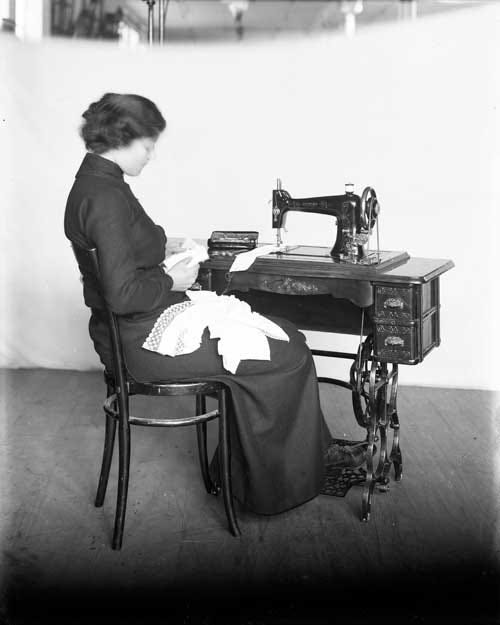
I never realized how much time my great-grandmother May spent behind the sewing wheel. But when I started reading her letters it was hard to miss. Nearly every letter mentioned some type of sewing project. She'd be sewing new spring curtains for her living room, or an apron to gift to a neighbor. Sometimes it was a new set of jumpers for her grown granddaughters or a new baby quilt for the latest great-grandchild, and that was all within just a month or two. As Christmas neared she started a marathon sewing schedule to ensure she got every set of new pajamas, robes, and/or fresh housecoats finished in time to be wrapped and mailed well before the holidays. Her trusty vintage treadle sewing machine was a workhorse. Its constant use made it perhaps the best investment May Hinkson ever made. Case in point here’s a small sampling of letter exerts noting her needle and thread activities from 1963:
I’m about to finish a pair of PJ pants for Penny since I figured out the insert the other pair will go faster. I got denim and a pattern for two pairs of shorts. And material for two blankets. (Letter #95, May 14, 1963)
I’m doing booties and a blanket – did you ever get the pair I sent you? I have one pair complete and two that lack only the tassels – I’m sending one pair to Jenny just as a token one was intended for Penny from the start – she said she had made four pairs so she will probably have all she wants. I have some material for a duster for Becky‘s birthday, but we have to wait for the pattern to come. We only order patterns from a book in LaBelle. (Letter #100, July 6, 1963)
I had to have material to start Christmas sewing so I had Cora take us to Edina on Saturday morning. I had real good luck and got sewing material to hold me quite a while. The quilt came out last night and tomorrow I shall bind it – Willard didn’t even have blueprint for the binding and when I went to get the blue, I thought I had decided maybe a doll dress had been made from – I made Bert and George’s PJs alike and one size – a little large for George I think – and Bill’s and Larry’s larger. Isn’t it fine to suddenly have four nice men in the family! (Letter #110, Nov. 18, 1963)
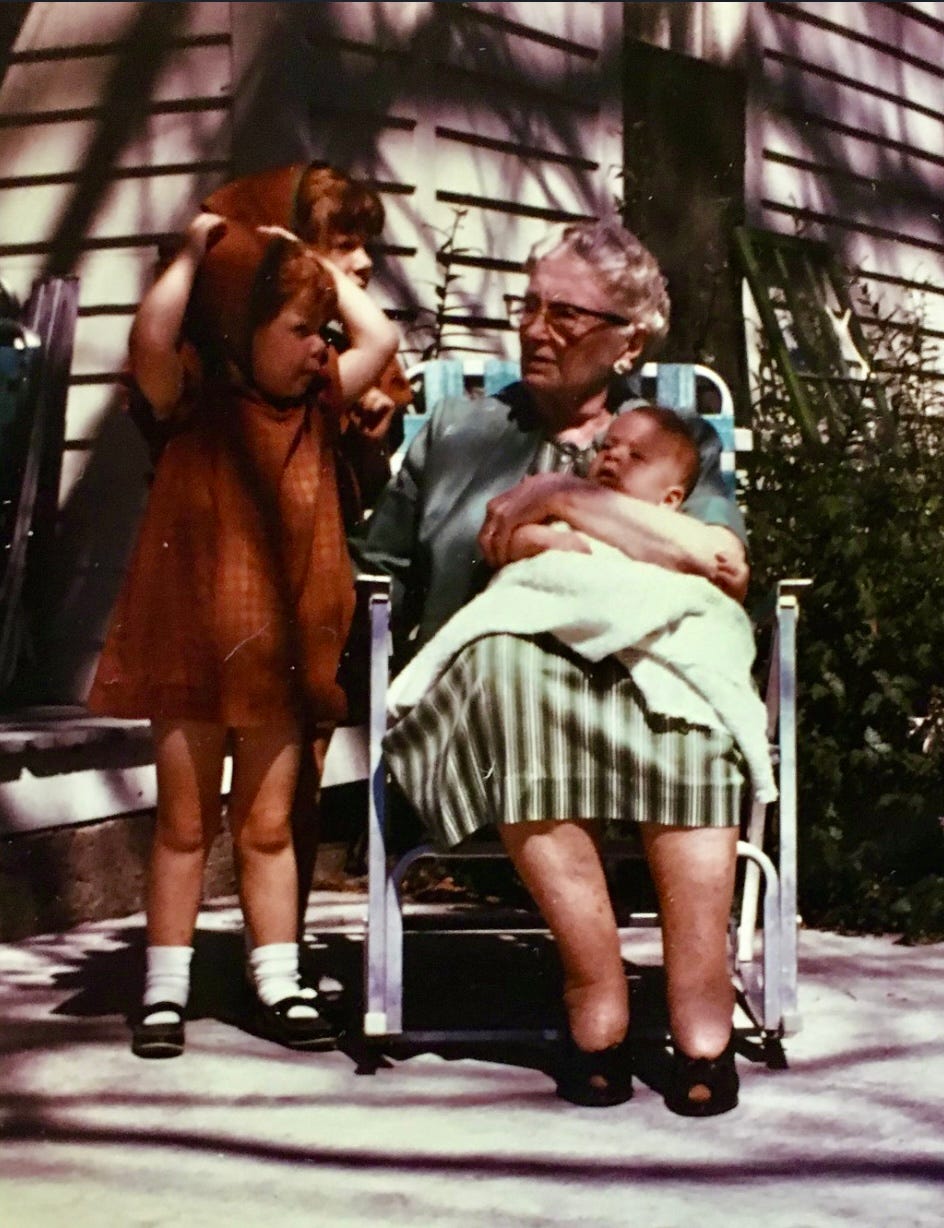
But in digging a bit deeper into my great-grandmother’s sewing efforts, I came across a discovery that shed a different light on her sewing activities. In addition to sewing significantly for her family, she was instrumental in leading the local LaBelle effort during WWI to sew for the “Sammies.”
One of my more interesting discoveries about my great-grandmother May was her local Red Cross leadership during the Great War (which was later named WWI after the Second World War started) to establish a LaBelle chapter for the Red Cross to assist in the production of garments and supplies for soldiers.
Back in 1917, as the United States entered the Great War in Europe, the Red Cross put out a call to women to form local volunteer chapters to assist in the sewing of hospital gowns, bedding, and much-needed surgical supplies. The needs were great and often dire according to Red Cross reports as there was not enough existing industry to supply the effort. In addition to surgical supplies, soldiers needed socks, helmet covers, sweaters, and other items to keep them warm in the trenches during winter. May Hinkson apparently heard the call in the spring of 1917 and started organizing her neighbors, friends, and church colleagues to form a La Belle Red Cross Volunteer Chapter.
In the summer of 1917 the American Red Cross put out an urgent call for knitted goods and hospital supplies to help fight the war. Their immediate need was for one and a half million each of knitted wristlets, mufflers, sweaters, and pairs of socks. The need for the socks was paramount: The trench warfare conditions under which the war was fought meant that soldiers spent weeks or months entrenched in wet and in winter freezing conditions.
“Knit for Sammie!” became the rallying cry of American Red Cross knitters. American soldiers were called Sammies, short for Uncle Sam, or doughboys…. Sammie needed wool helmets and vests, chest covers and fingerless mitts to allow trigger access. Knitters also produced so-called stump socks to cover amputated limbs. The Red Cross issued patterns and yarn, collected finished goods, and shipped them to Europe. (HistoryLink.org https://www.historylink.org/File/5721, accessed 16 March 2025)

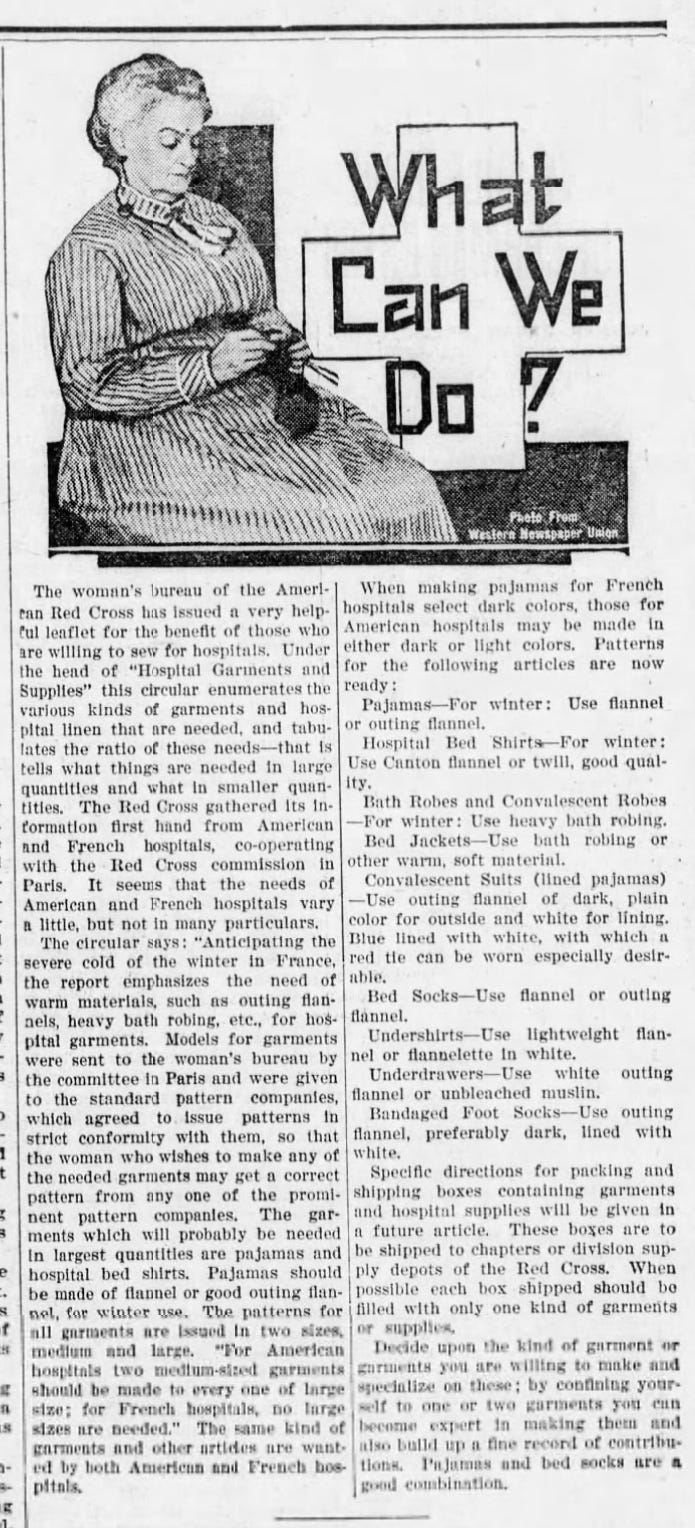
Local chapter requirements were a light lift with only ten members needed to establish a chapter. May, along with the support of nine other neighbors, each contributed a dollar ($1 in 1917 = $25 in 2025) to establish an operating fund for the purchase of materials. Fortunately, enthusiasm for the effort was strong throughout the La Belle community. Within a few weeks, membership in the local chapter had grown to a whopping 212 members. With the town’s population hovering at the time around 900 residents, the commitment by the women of the community was truly impressive.
One of the first tasks in forming the local Chapter was to designate leadership for the Red Cross application. May Hinkson (aka Mrs. H. T. Hinkson) was immediately nominated and elected as Chapter Chair. Her leadership was reinforced a month later after the Chapter received approval when she was also elected as the “permanent Chair.”
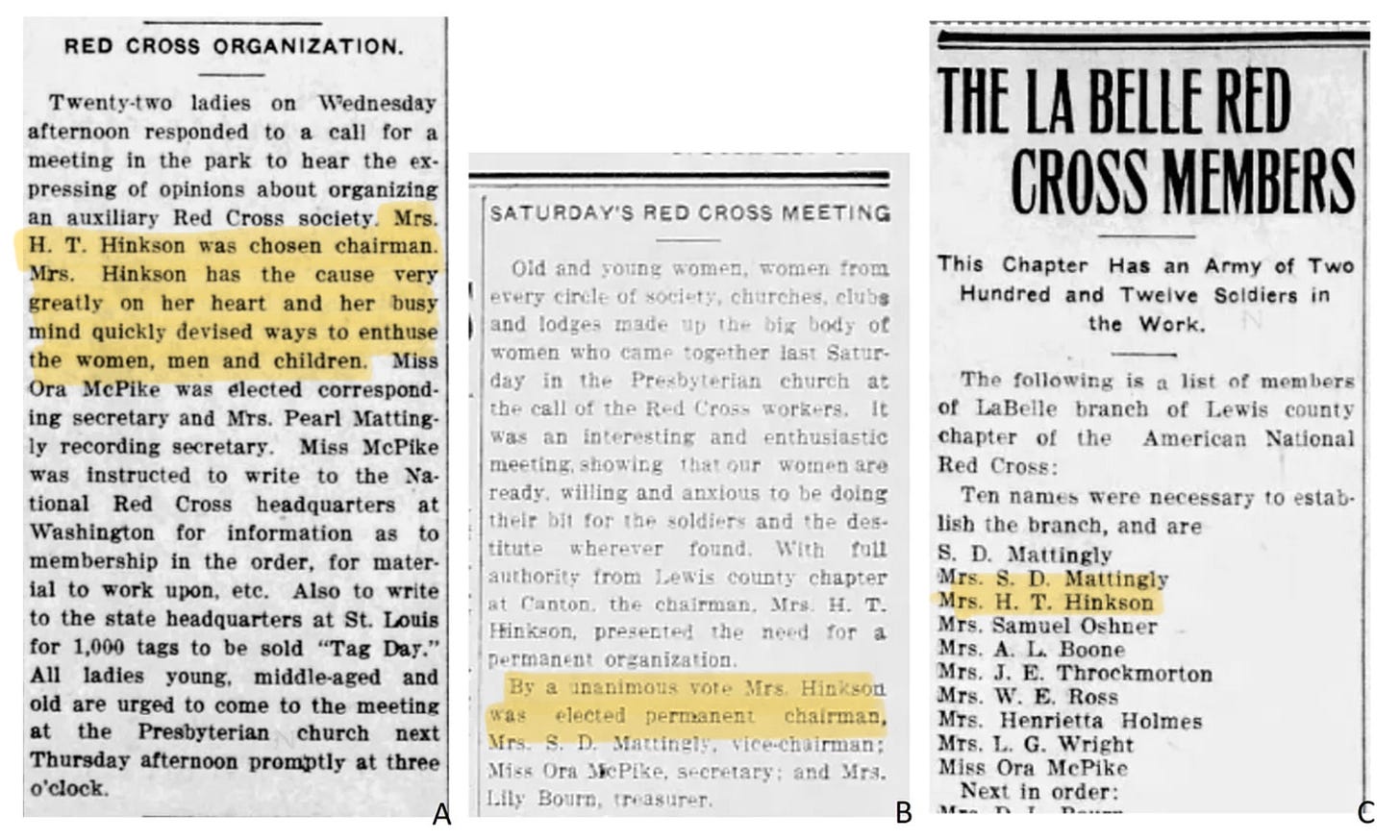
As work began to solicit monetary donations through “tag sales” for the purchase of supplies (material, thread, and yarn), May began working with other elected leaders to divide the effort between tag sales, sewing, knitting, and surgical dressings. By mid-July, before even the first surgical garment had been sewn, the chapter had secured 152 “tag subscriptions” from local residents, each contributing one dollar a month to support the Red Cross sewing efforts.

One of the first things needed was a central location for meetings, sewing instruction, and completed garment drop-off. The Smith Building (later moved to the Old Fellows Hall) on the south side of Main St. was quickly offered up as a meeting and sewing room. Four community machines were immediately loaned towards the effort. Through a local merchant, the Singer company also donated the use of three additional sewing machines (until they were sold). Women were encouraged to sign up for sewing shifts and attend the Red Cross classes offered in garment and sewing instruction. For those with knitting talents instruction books were given out. Those without either sewing or knitting talents could contribute to the effort by assisting with packaging, shipping, and collecting donations. A second room over the LaBelle Savings Bank was secured for the creation of surgical dressings. Everyone, no matter the age or the talent, was encouraged to find a way to contribute to “our boys overseas.”Within several weeks of securing the sewing room production of both surgical supplies and knitted items was running high. Throughout the next fourteen months, the women of LaBelle would produce thousands of surgical supplies as well as hundreds of bedding, clothing, and knitted items. This newspaper extract from March 1918 notes an impressive contribution by LaBelle women, including 1,050 surgical dressings as well as numerous other items completed and shipped for the week of March 1, 1918:
Additionally, the Star newspaper reported weekly on the activities of both volunteer sewers and knitters. The two news items below provide nice descriptions of the town’s people all coming together. Even the “children, both boys and girls” helped “to serve their country by their bits of knitting.” The second article, additionally notes the resolve of the volunteer workers in the face of great loss. “Our common sorrow and need has unified all women as nothing else could. We feel that the spirit of union of thought and service will never be undisturbed.”
By June 1918, May Hinkson had taken a new Red Cross chapter appointment as head of publicity. After serving as Chair for the first year she stepped aside to provide others the opportunity to lead.
The Chapter had been going strong for eighteen months when Germany finally agreed to a peace deal with the Allied forces on November 11, 1918 (Armistice Day). The news of the official armistice initially reached La Belle by telegraph. Once it was confirmed, the town built a huge bonfire just north of State St. and shot off fireworks that had been hastily acquired from nearby Quincy. And according to a community member’s remembrance published years later in the Star in 1961, a “train came through LaBelle in November 1918 early in the morning - whistle blowing constantly with banners flying - saying the “war is over.” These two articles from The LaBelle Star recount both the celebration and the Red Cross Chapter notification. I never did find the “list of dressings” noted in the Red Cross article (below) which was supposed to be printed as a follow-up. I assume the excitement of the “boys coming home” easily overshadowed pulling this together.
I wish a photo existed of LaBelle’s momentous Red Cross effort, but to date, I have not been able to locate any. What I have found instead is a small LaBelle Star News article written by my great-grandmother May, that was published in 1972.
This photo from an Indiana Red Cross chapter shows a sewing room similar to what I imagine LaBelle had in the Old Fellows Hall.
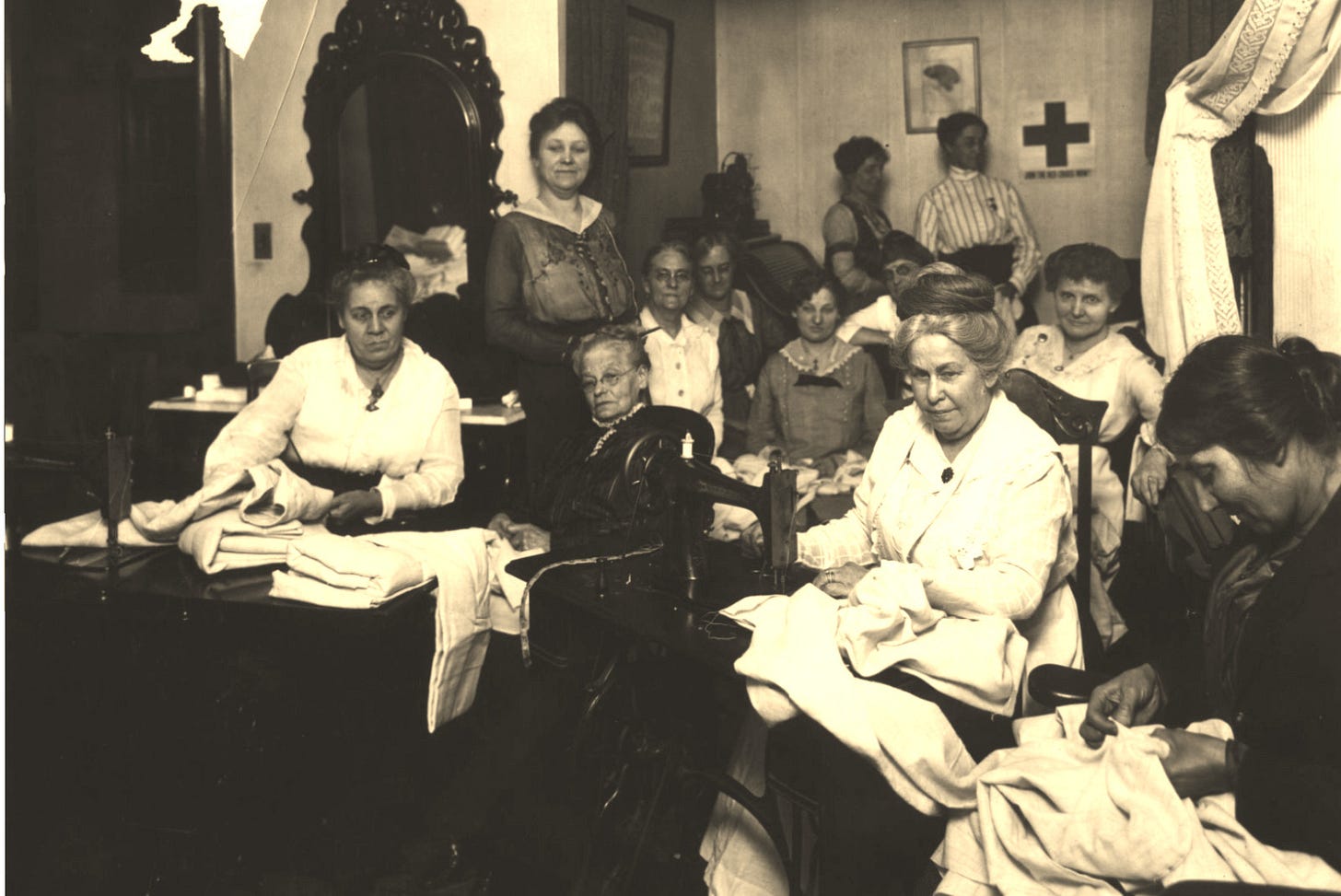
Fortunately for May, neither my great-grandfather Tom (her husband) nor my uncle Robert were drafted for the war. Although Tom registered at age 43 he was never called up. Robert, age 13, was too young.
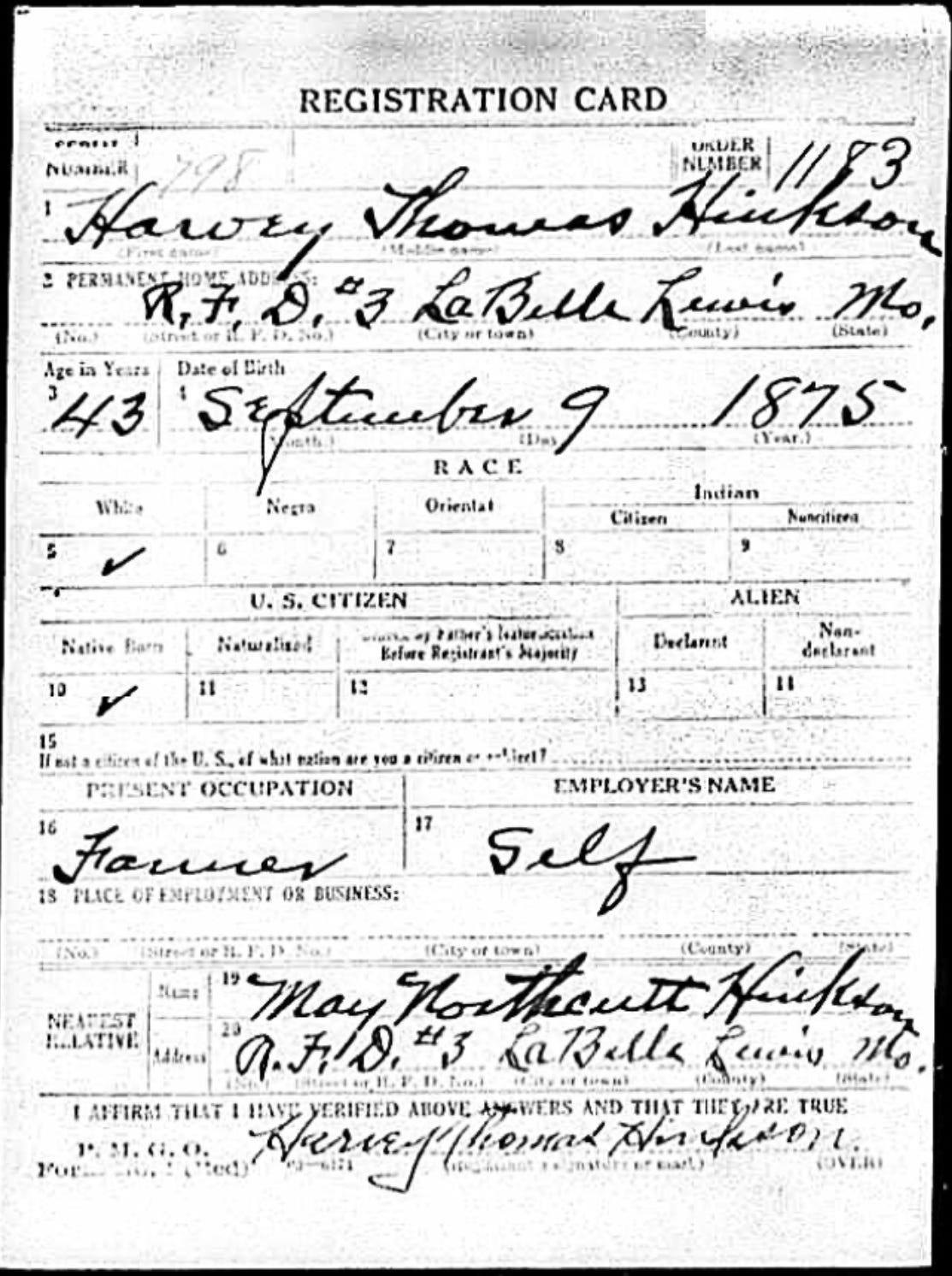
The Hinkson family did have one young relative who served, Harvey Hinkson (the son of Tom’s brother John Edward). Harvey was called up in the summer of 1918 and spent a short time in France. Fortunately, he made it home safely. But upon his return, he learned of the tragic losses of both his brother Ermine and niece. Both died from the other worldwide event of 1918… the Spanish Flu epidemic.
In closing out this chapter I thought I would highlight one of my great-grandmother’s letters that not only commented on her sewing but also included a few clippings of the material. It’s clear my great-grandmother’s lifelong pursuit of stitching material together allowed her to combine two of her greatest loves… her family and her sewing.
letter #154 Postmark, December 14, 1964 address Mrs. Douglas Green, Lansing, MI (Note this letter contains two small clippings of plaid material)
Monday a.m.
Dear Helen,
This may be the last bit of communication until I see you about 9:30 AM December 23 at the bus station in East Lansing. I think it will be an easy way to come and I’ll see my St. Louis family and Ray and Nell. Jean just brought Ginny’s jumper by. There were five big button holes down the front of the skirt and I thought it would be better to have them done on a machine. My buttonholes are substantial but they aren’t. Pennies shift is darling – it is the same material as Jenny‘s but a different plaid – hers is blue and Jenny is gray. I had time to make my little Debby (paper girl) a corduroy skirt and there was a blouse at Willards. He had no dress in her size. Except – Ray, Nell and Marie. I’m all wrapped up for Christmas. Marie wanted percale sheets, which aren’t available here so I’ll get them in St. Louis. And for Ray and Nell I’m getting each one of those boxes of stationary with several sheets to each envelope and I’ll include a dollar stamp book. Nell says it is hard for them to get to the stamp window and it will save carrying them.
It was good to talk to you and Virginia last night and Penny and Bert and the St. Louis folks Saturday night. I got part of my cards ready last night. Josephine Woodard took me to see Lottie Saturday and I’ll have Margaret take me up to say merry Christmas to the nice old ladies at Knox and two Charlie. I’m so full of spirit of Christmas I’m about to burst.
I love you and thank you – Mother [May Emma Northcutt Hinkson].

